This article has been published today by the Higher Education Policy Institute (HEPI). HEPI is the UK’s only independent think tank for higher education, and aims to shape higher education policy debate through evidence.
New research on the stereotypes formed at a young age, their long-term impacts and what can be done to tackle them successfully
Research just published in the USA reinforces findings from recent UK studies about who children meet in their day to day lives and the impact this has on their aspirations, future study paths, and long-term career choices.
The University of Houston study finds that children from the age of six often rule out options for themselves because of the ingrained stereotypical views they have about the jobs people do based on their gender, ethnicity and socio-economic backgrounds. These aspirations are often based on their family’s experiences and the people in their immediate surroundings.
New research from the UK shows that once established at a young age this mindset is difficult to change later and influences the subjects they study and the career paths they take as adults.
This blog explores the research and considers what more can be done to tackle the issue and better support existing schools’ outreach and widening participation programmes.
Stereotypes start early
The study by Master, A., Meltzoff, A. N., & Cheryan, S. from the University of Houston, Gender stereotypes about interests start early and cause gender disparities in computer science and engineering, National Academy of Sciences, published on 30th November 2021, found that:
the common societal stereotypes that girls are less interested than boys in computer science and engineering, are endorsed by children and adolescents in a large and socioeconomically diverse sample, across multiple racial/ethnic and gender intersections, and as early as age six.
The authors argue that gender-interest stereotypes may contribute to subsequent gender disparities in the pursuit of these important fields and that addressing such stereotypes may help improve educational equity. The study shows:
- the existence of gender-interest stereotypes favoring boys among young children and adolescents across multiple racial/ethnic and gender intersections in the United States;
- that gender-interest stereotypes causally influence subsequent academic motivation (e.g., children’s own interest in pursuing, choice of, and sense of belonging in computer science activities); and
- that gender-interest stereotypes more strongly predict academic motivation to pursue computer science and engineering.
The reality of gender stereotyping starting at a young age was captured in our two-minute filmRedraw the Balance published in March 2016; 66 children aged 5 to 7 were asked to draw a picture of a firefighter, a surgeon and a fighter pilot. 61 drew men, five drew women. They were then asked if they would like to meet real-life versions of their drawing and the film captures their reaction. It has been viewed over 100 million times and recreated in a number of countries including Canada, China, Denmark and most recently in South Africa.
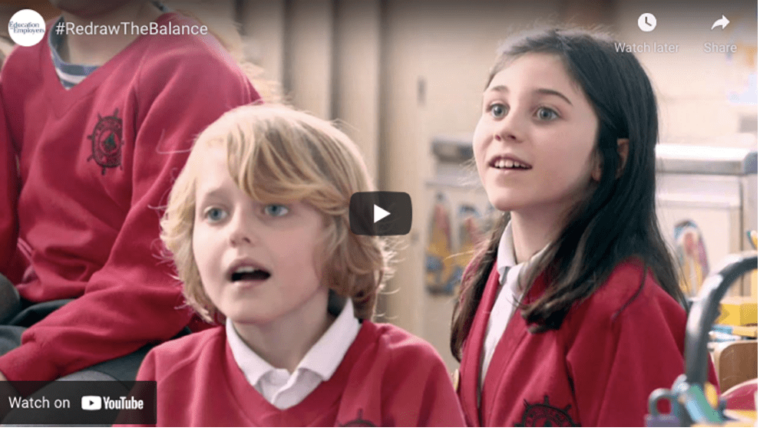
Stereotypes are a global phenomenon
Following the reaction to the film the Education and Employers charity decided to undertake a survey of 20,000 children aged 7 to 11 in 19 countries. The Drawing the Future study was done in partnership with OECD Education and Skills, UCL Institute of Education, the National Association of Head Teachers and TES. Published in Davos in January 2018, it found that:
- gender stereotyping about jobs is set from a young age and is a global issue;
- family, TV, radio and film have the biggest influence on children’s choices; and
- only one per cent of children have heard about a future career from someone outside their immediate environment visiting their school and talking to them.
Stereotypes and narrow aspirations
Building on this and using the same research methodology the New Zealand Government in March 2020 undertook a study of 7 to 13 year olds examining who / how they were being influenced.
The results showed marked differences between the jobs girls and boys aspire to, with for example 10 times more girls than boys wanting to become teachers and 4 times more boys than girls aspiring to become engineers. They also revealed the narrowness of career choices:
More than 50 per cent of drawings for both boys and girls show just nine jobs: sportsperson – way ahead at almost 17 per cent – vet, police officer, teacher, social media influencer, artist, doctor, military or firefighter, and farmer.
The results show that unconscious bias caused by a child’s race, gender and socio-economic status can have an early effect on career choice… Such bias can affect the choices made later in life, such as subjects studied at secondary school and training or education pursued after graduation.
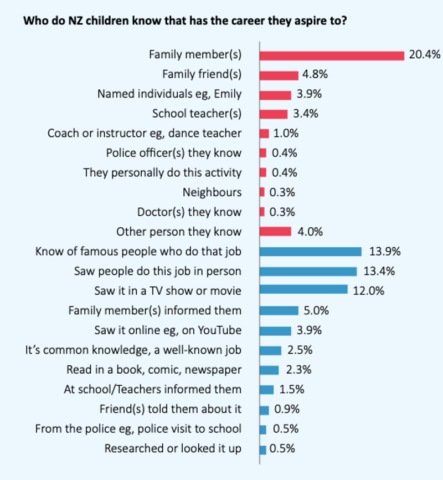
Professor Louise Archer and her team at the UCL Institute of Education have similarly revealed the narrowness and stereotyped nature of career ideas early in primary school and the sentiment against STEM careers, particularly among girls, that is persistent from age 10 to 18, despite many finding science enjoyable and important (Archer et al, 2020).
This work has been reinforced by surveys of children, including most recently an analysis of 4,000 five-year-olds in England and Estonia. The OECD’s Future at Five report published in March 2021 found that gender norms were already strongly evident in job preferences at the age of 5.
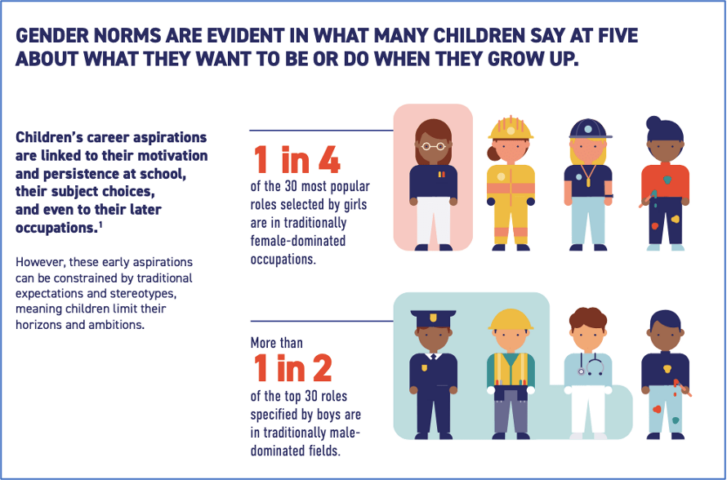
Stereotypes stick
Of course, the jobs many of us first dreamed about as children, for example becoming an astronaut, a ballet dancer, a superhero or a magician changed as we got older. But some ideas do persist. The most popular job in the 2018 Drawing the Future study for girls was teacher (18.6 per cent) and for boys, sportsperson (34.1 per cent) with other popular choices being doctor, police officer and vet.
The OECD report on the career aspirations of 15 year olds; Dream jobs: Teenagers’ career aspirations and the future of work, published in January 2020 found that:
47 per cent of boys and 53 per cent of girls surveyed in 41 countries expect to work in one of just 10 popular jobs by age of 30. Traditional 20th century and even 19th century occupations such as doctors, teachers, veterinarians, business managers, engineers and police officers continue to capture the imaginations of young people as they did nearly 20 years ago, before the era of social media and the acceleration of technologies such as artificial intelligence in the workplace.
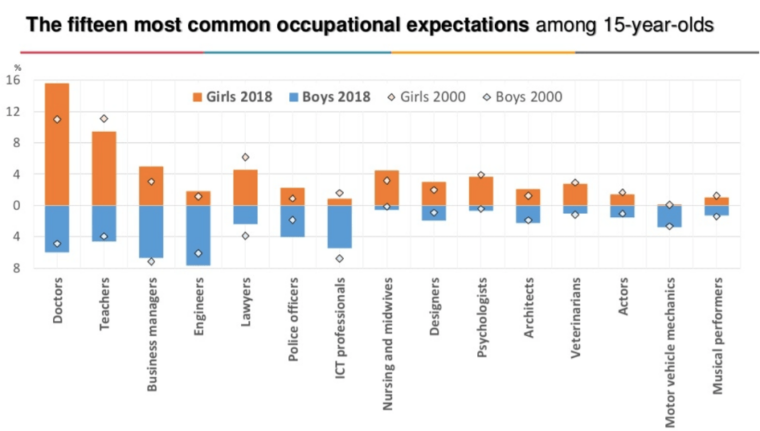
Dream Jobs, OECD, Jan 2020
Mismatch with the labour market
Using data from the Drawing the Future study we mapped the career aspirations of children in the UK aged 7 to 11 against those of 17 to18 year olds and projected labour market demand (C1 to C26 representing different economic sectors).
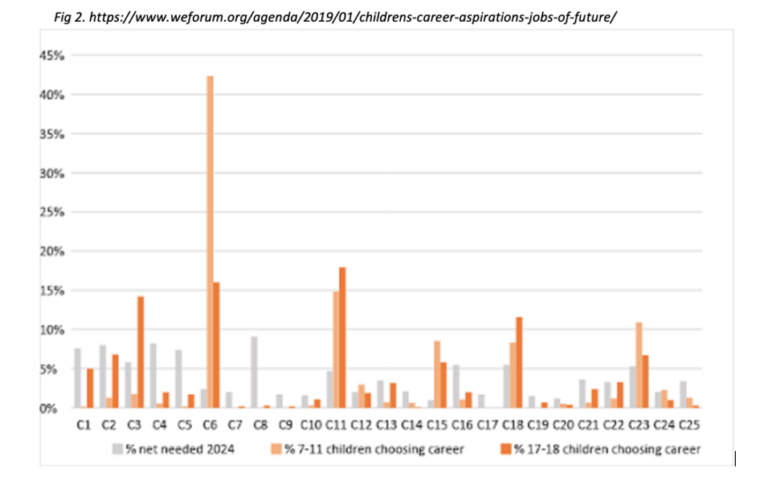
The analysis showed that the types of jobs 7 to 11 year olds are choosing are similar to those of 17 to 18 year olds – with the top choices being culture, media and sport occupations (C6) and have little in common with current labour market demands.
Tackling stereotypes and improving motivation
In 2014 a national programme was launched to help tackle some of the ingrained stereotypical views children sometime have and to broaden their horizons. The Primary Futures programme developed in partnership with the National Association of Head Teachers, who represent some 98 per cent of primary heads, also sought to help improve children’s motivation.
Their head teacher surveys had found that some children struggle with academic motivation if they can’t see the relevance of schooling to their future lives, particularly if they are from families who have seen little personal evidence of positive benefits from schooling. The findings were similar to what Professor Archer’s research team on STEM subjects has identified through the ASPIRE project. Children with low ‘science capital’ struggle to see the application of science to jobs other than doctor, science teacher or scientist. They disengage because they do not see the relevance of the subjects to their life.
The Primary Futures programme gives children the chance to meet and interact with a wide range of people from diverse backgrounds. People doing different jobs in different sectors, including many from HE – staff and alumni. Volunteers and schools are connected quickly and easily using specially developed state-of-the-art match-making technology – Inspiring the Future.
Understanding the impact
In order to understand the impact the programme was having and how it could scaled up a study was undertaken involving 370 primary schools across 114 local authorities with detailed responses from 10,000 children. The findings of the study, Scaling Up, the largest of its type undertaken found that it was effective:
- in challenging stereotypes that children often have about the jobs people do based on their gender, ethnicity and socio-economic background
- achieving gains in attitude to school and learning, and improved attainment and engagement, with 82% of children more motivated in core subjects of maths, English and science
- realising positive impacts on children’s ambitions and ideas about their futures, with 88% understanding how doing well at school is helpful to them in later life
- achieving greatest impact on children from disadvantaged backgrounds, who often don’t get access to a diversity of role models, which has been especially the case during lockdown with gains in confidence, speaking, listening and aiming high/trying hard
One of the reasons the study suggested for such increases was because many children from disadvantaged backgrounds do not routinely have the opportunity to meet a wide range of successful professionals. They might have high aspiration, but these aspirations might be quite narrow, simply because of the small number of role models from the world of work they meet. As the US civil rights activist, Marian Wright Edelman says, ‘You can’t be what you can’t see’.
These finding were included in Education and Employers’ Starting Early report. Published in March 2021 this brought together a wide range of UK and international studies, together with an examination of government policies in this area.
The need to do much more at primary school level
The publication of the Starting Early report coincided with UCAS’s Where Next report. Their analysis identified that one-in-three applicants report first thinking about HE at primary school and that disadvantaged students are more likely to consider HE later, which can limit their choices, especially for more selective subjects and higher tariff providers. It recommended that:
universities and colleges, working with UCAS and partners, to undertake more targeted outreach work within primary schools
And as Nick Baker in a recent HEPI blog, describing the work he is doing with primary schools, said, ‘Outreach to schools is more necessary than ever’.
Connecting easily with schools anywhere in the country
As we are all too aware the COVID-19 pandemic has had a massive impact on young people’s lives. And those from disadvantaged backgrounds have been disproportionally affected with the attainment gap likely to widen in coming years.
The pandemic has also seen us all becoming much more familiar with using technology to connect and interact on screen. The opportunity now exists to use these very technologies and new ways of working to help tackle the widening disparities.
In the past Primary Futures relied on people visiting their local schools. While in-person visits are important and will continue to be so, it has been considerably enhanced by the interactive virtual programme schools have pioneered. It gives them, wherever they are located in the country, access to all our volunteers – over 65,000 people have already registered together with 5,000 primary schools. It enables young people to interact with people from an amazing diversity of backgrounds and experiences – spanning all different sectors, job levels and career routes – people from different social, economic, and ethnic backgrounds.
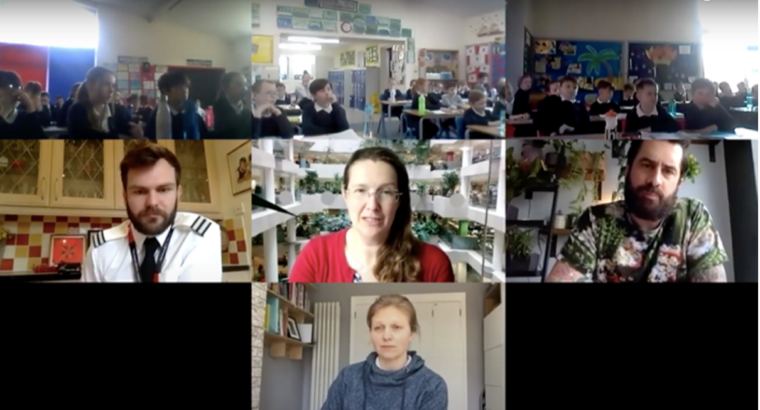
Example of an interactive virtual Primary Futures session
So if you are a primary aged child living in Lichfield, you can meet and ask questions of an engineer working on green energy wind turbines off the Norfolk coast; if you live in the centre of Birmingham you can hear from an agricultural scientist working in Hampshire; if you live in Aberdeenshire, you might talk with a cancer specialist in Swansea; and if you live in a rural hamlet in Cumbria you can quiz a digital animator working in film production in Salford.
It is also easier than ever for people to volunteer – even just an hour a year makes a difference. It means that children growing up in deprived areas of the country get more opportunities to see a diverse range of jobs, beyond those of their parents, neighbours and local community.
We owe it to our young people to help them become excited by learning and by their own potential, to see the diversity of what is possible, and to make informed decisions about their future – and this opportunity needs to start in primary schools.
Nick Chambers, CEO, Education and Employers
HEPI have published a wide series of articles – visit their website to read them.
